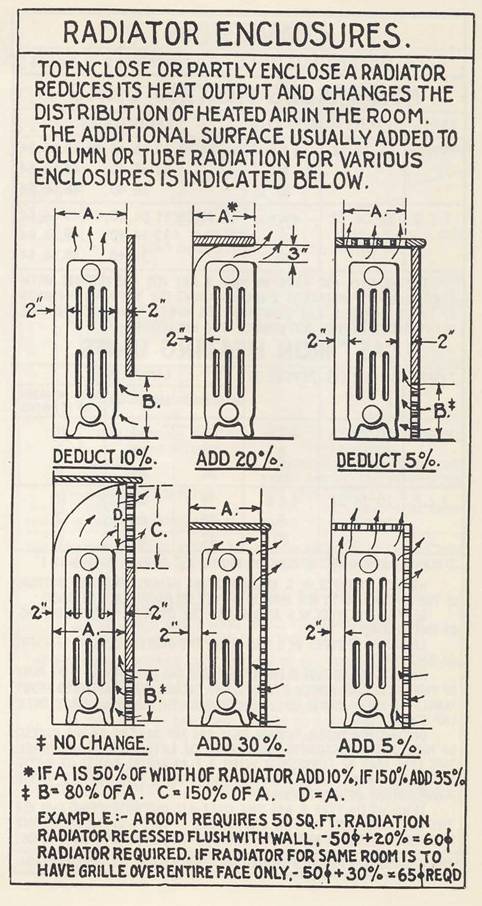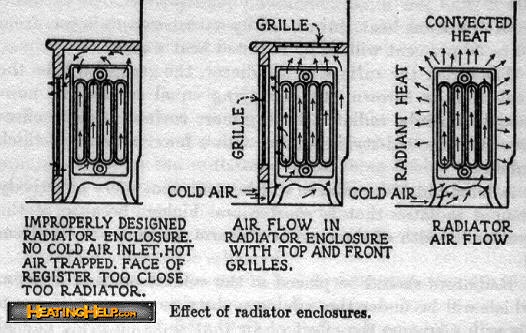In this presentation, Gary Klein shares important information about air source heat pump water heaters (HPWH), with particular attention paid to where the warm air comes ...
Radiator Covers
Let’s take a look at radiator enclosures. Some people use them because they think old radiators are ugly (I sure don’t). Others use them to protect children from burns (I recall touching a red-hot steam radiator when I was a kid growing up in New York City, but I only touched it once). Still others think that by using an enclosure, they’ll get more heat from the radiator, and this will be true if it’s the right enclosure. The folks who market enclosures often claim that their products will increase a radiator’s output, but that’s not always true. Often, the enclosure will decrease the output. It all depends on how the air flows through the enclosure.
Take a look at that chart to your right. It's from the old days. We'll go over each drawing, starting from the top, left to right.
First, we have a radiator with a solid board in front of it. That board is going to create a chimney effect for this radiator. The air that comes in contact with the hot metal will quickly rise, drawing in cool air from the bottom of the board. Because more air will come in contact with more hot metal, the chart tells us to deduct 10%. What that means is that if you have a room that needs a radiator capable of putting out, say, 100 Square Feet E.D.R., you could use a radiator rated at 90 Square Feet E.D.R. in this case because the board is increasing the air flow across the radiator. It’s similar to what happens when you start a fan and allow it to blow across a radiator. More air flow means more heat output.
Okay, move to the right. This next radiator has a simple shelf across its top. That shelf is impeding the air flow off the hot metal, so we’re going to have less convection with this one. If we needed 100 Square Feet E.D.R., we’d have to size the radiator for 120 Square Feet E.D.R. to compensate for the lesser convection. Make sense? (This could actually help you if the radiator is too big for the room.)
The radiator to the right of that one has an enclosure that’s similar to the first one. We have a solid front and a top and bottom that are perforated with lots of holes, giving air a way in and out. Because of this design, we can deduct 5%. So if you needed 100 Square Feet E.D.R., you’d be able to get by with 95 Square Feet E.D.R.
Oh, and this is a good point to mention that when you’re measuring radiators for a boiler replacement, please ignore those enclosures in your measurements. You have no way of knowing whether someone will remove those enclosures as time goes by. Better to be safe than have a boiler that’s suddenly too small or too large.
Let’s move to the bottom row, starting on the left. This next enclosure is well-made and it neither slows the air nor speeds it up, so there will be no change in the radiator’s output.
Moving to the right, we see the classic radiator enclosure. This is the one that you’ll see lots of companies selling nowadays. It has a solid top that’s usually hinged (so that when you open it you can see all the cobwebs and other crap that’s fallen in there). It also has a perforated wood or metal front, drilled with hundreds of holes. There’s little or no chimney effect with this enclosure so we have to add 30% to its size if we want the same output that we’d get without this enclosure. So if we need 100 Square Feet E.D.R., we’d have to size for 130 Square Feet E.D.R. And once again, don’t add that to your measurements when you’re sizing a replacement boiler.
Finally, we have this last one on the lower right. This is very similar to the previous one (there are lots and lots of holes in the front) but we’ve added holes to the top so that’s going to let the hot air escape. You’ll have to add 5% to this one; so to get 100 Square Feet E.D.R., you’ll need to size for 105 Square Feet E.D.R.
And keep in mind that you are not the one sizing the radiation to the room’s heat loss. The Dead Man did that years ago. He may or may not have sized for these enclosures. You have no way of knowing unless you do a heat-loss calculation on the room as it was in the old days (and how are you going to do that?). And then you’ll have to check the size of the radiator against that heat loss. Trust me on this. If you’re measuring radiators for the purpose of replacing the boiler, take the measurements as if the enclosures were not there. You’ll be fine.
Oh, and notice how in all of these drawings, the radiator is positioned two inches away from the wall, and two inches away from the front of the enclosure. That’s an ideal spacing for air flow. Keep this in mind if you ever have to move a radiator.
Additional thoughts from Frank "Steamhead" Wilsey.
Here's another take on radiator cabinets. This is from First Aid for the Ailing House, by Roger B.Whitman, 1934.
I was also going to post some images from Kidder & Parker's Architect's and Builder's Handbook, but they turned out to be the same as Dan's. Some time ago I worked out the change in output when adding a cover to an existing radiator. Going by the radiators shown in the chart above, if you add the type of cover listed as "Deduct 10%", the existing rad will run at 111% of its uncovered capacity.
The cover listed as "Add 20%" will make the radiator operate at 83% capacity.
The cover listed as "Deduct 5%" will make the radiator operate at 105% capacity.
The cover listed as "Add 5%" will make the radiator operate at 96% capacity.
And finally, the cover listed as "Add 30%"- the alleged "design" we see all the time- will make the radiator operate at 77% capacity.
I'm not a big fan of radiator enclosures, as they can hide small leaks as would occur with a loose packing nut or union, or a bad air vent. But if you must build an enclosure, doing it the right way will conserve energy.

Leave a comment
Related Posts
This all-technical, three-hour seminar will make you familiar with the many types of old steam heating systems and what goes wrong with them. Dan Holohan’s easy-to-follow...

In this all-technical three-hour seminar, Dan Holohan will give you a Liberal Arts education in those Classic Hydronics systems. He’ll have you seeing inside the pipes as...